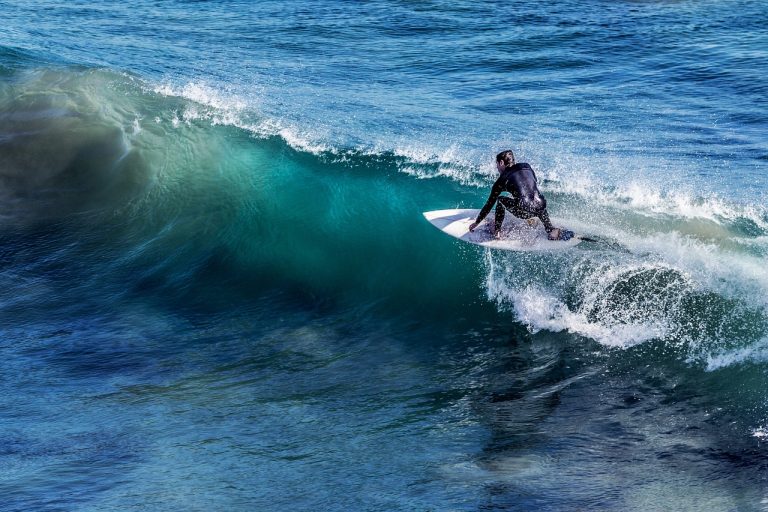The Dominican Republic, especially the areas surrounding the many Punta Cana all inclusive resorts, a tropical haven renowned for its pristine beaches and turquoise waters, is not just a destination for sunbathers and snorkelers, but also a hidden gem for surfers of all levels. From gentle, rolling waves for beginners to powerful, barreling breaks for seasoned pros, Punta Cana offers a wide variety of surf spots to suit all tastes.
Vagabondish is reader-supported. When you buy through links on our site, we may earn a small affiliate commission. Read our disclosure.
For the Beginner Surfer
If you’re new to surfing or looking for a mellow wave to practice your skills, there are plenty of spots for Punta Cana surf novices:
Playa Macao: This long, sandy beach is a popular choice for beginners due to its consistent, gentle waves. The gradual slope of the seabed makes it easy to paddle out and catch waves without feeling overwhelmed. The calm, clear waters also provide excellent visibility for learning to read the waves and timing your take-off.
Bavaro Beach: While primarily known for its resorts and calm waters, Bavaro Beach does offer some gentle surf, especially during the winter months when the swells are larger. This makes it a good option for beginners who want to practice in a more sheltered environment.
For the Experienced Surfer
For experienced surfers seeking serious Punta Cana surf thrills, there are plenty of world-class spots that offer powerful waves and exciting breaks:
Playa Blanca: Located on the eastern tip of the Dominican Republic, Playa Blanca is a remote and rugged beach that offers some of the most powerful waves in the region. The consistent swells and strong currents make it a challenging but rewarding spot for experienced surfers. It’s important to note that Playa Blanca can be dangerous, so it’s crucial to surf with a local guide and be aware of the strong undercurrents.
La Boca: This small fishing village is home to a few excellent surf spots, including a point break that offers long, peeling waves. The quality of the surf at La Boca can vary depending on the swell direction and tide, but when the conditions are right, it’s a surfer’s paradise.
El Caleton: This secluded beach is a hidden gem for experienced surfers. It offers a variety of breaks, from gentle beach breaks to powerful reef breaks. The consistent swells and clear waters make it a popular spot for surfing and other water sports.
Best Time to Surf in Punta Cana
The best time to Punta Cana surf is during the winter months, from November to March. This is when the swells are larger and the winds are more favorable for surfing. However, good surf can be found year-round, especially during tropical storms and hurricanes, which can bring powerful swells to the region.
Safety Tips for Surfing in Punta Cana
Respect the locals: Always be respectful of local surfers and customs.
Surf with a buddy: Never surf alone, especially in remote areas.
Know your limits: Don’t surf in conditions that are beyond your ability.
Be aware of marine life: Watch out for sharks, stingrays, and other marine life.
Protect the environment: Leave no trace and respect the marine ecosystem.
By following these tips, you can enjoy a safe and unforgettable surfing experience in Punta Cana. Whether you’re a beginner or an experienced surfer, Punta Cana’s diverse range of surf spots has something to offer everyone.
Getting to Punta Cana
The most common and convenient way to reach the Dominican Republic for your Punta Cana surf vacation is, of course, by air. Punta Cana International Airport (PUJ) is a major hub with numerous direct flights from various international destinations, including major cities in the United States, Canada, Europe, and South America.
Once you land at PUJ, you have several options to reach your hotel:
Taxi: The most straightforward way is to take a taxi. It’s a quick and comfortable option, especially if you’re traveling with luggage.
Shuttle bus: Shared shuttle buses are a budget-friendly choice. They pick up passengers from the airport and drop them off at various hotels along the coast.
Private transfer: For a more personalized and luxurious experience, consider booking a private transfer. You’ll be picked up at the airport and driven directly to your hotel.
No matter which option you choose, it’s advisable to arrange your transportation in advance, especially during peak tourist seasons. This will ensure a smooth and hassle-free arrival in Punta Cana.


